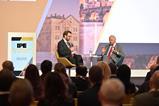Surging inflation and global economic uncertainty has prompted sovereign investors to re-examine their asset allocation, with private markets the main beneficiary, according to the latest Invesco Global Sovereign Asset Management Study.
Now in its tenth year, the report canvasses the views of 139 chief investment officers, heads of asset classes and senior portfolio strategists at 81 sovereign wealth funds (SWFs) and 58 central banks, who together manage $23trn (€22.8trn) worth of assets.
Although Invesco’s research found that sovereign wealth funds’ fixed-income allocations have declined steadily in recent years, it also revealed that these investment allocations are bypassing equities in favour of private market alternatives, notably real estate, private equity and infrastructure, which 71% of respondents agreed are effective inflation hedges.
While some of those questioned raised concerns about deal flow and restricted supply driving valuations higher, private assets now constitute, on average, 22% of sovereign wealth funds’ portfolios, the highest proportion on record, with the figure rising to 27% for the larger funds with assets under management (AUM) of at least $100bn.
In total, sovereign wealth fund investors now own $719bn in private assets, up from $205bn in 2011.
Interest in private assets looks set to continue. When asked which asset classes they intend to increase, maintain, or decrease exposure to over the next year, private equity, with a net increase of 29% was the most popular, followed by unlisted real estate (23%).
By contrast, respondents were most bearish on fixed income (-12%) and cash (-4%), while sentiment on equities is broadly unchanged (1%).
Rod Ringrow, head of official institutions at Invesco, said: “Uncertainty has been the word dominating investors’ conversations so far this year. After a relatively predictable few years, consensus over the direction of the global economy has broken down. This, paired with the potential end of a multi-decade bull run in fixed-income markets, is creating a new backdrop for sovereigns.
“While many are looking to private markets for solutions, we should not overstate the pace of this shift. As long-term investors, sovereigns are treading very carefully, and many are making only incremental changes to their portfolios, adopting a ‘wait and see’ approach.”
Ringrow also highlighted that sovereign funds are increasingly open to working with external advisers, especially as they move into complex, hands-on areas of private market investing.
He said: “Sovereigns are aware that increased scale and broader operations can, in fact, be a hindrance to strong performance. However, partnerships and outsourcing are not just about lowering operational costs; in fact, harnessing others’ expertise is by far the most popular driver of externalisation.
“Delivering alpha at scale is difficult, especially in markets that require in-depth knowledge and hands-on management, so it’s unsurprising to see sovereigns embrace solutions to navigate ‘uncharted territory’ and overcome these challenges.”
“Delivering alpha at scale is difficult, especially in markets that require in-depth knowledge and hands-on management”
Rod Ringrow, head of official institutions at Invesco
Ukraine invasion derails enthusiasm for Europe
In early 2022, many SWF investors saw good value in Europe, especially when compared with the US. However, this sentiment changed after Russia invaded Ukraine, with investors fearing harder to contain inflation which they worried would curb growth.
Ringrow said: “Unsurprisingly, developed Europe (19%) and emerging Europe (13%) are the geographies to which sovereign wealth fund investors are most likely to decrease exposure. Respondents are most likely to increase exposure to North America (33%) and Asia-Pacific (23%).”
Increased interest in ESG
Over the past five years, Invesco’s study has tracked a rapid uptick in ESG adoption by both central banks and sovereign wealth funds. It found in 2017 that 11% of central banks and 46% of SWFs had an ESG policy in place. This year the numbers stand at 47% and 75%, respectively, with a further increase on the previous year.
With three-quarters of SWFs now incorporating ESG, many that had previously been resistant have come on board. For some, the reputational risk of swimming against the tide has been a significant driver.
As one development sovereign based in the Middle East said: “Historically, we have been a very low-profile shareholder. However, the regulatory environment has prompted us to take a position, and ESG is becoming a very big deal. If you don’t provide a good story to tell the public, the public creates its own narrative, and this narrative is often wrong.”
Invesco’s Ringrow believes that all of the sovereign funds have recognised that they have a duty and are being increasingly required by their governments and local populations to take a stronger view on ESG.
“Over the past few years there has been increasing interest in green or blue hydrogen projects, cleaner energy and opportunities for impact investing. This has become a much more interesting topic for the development sovereigns. Indeed, the survey shows that 41% of sovereign investors now believe that impact investing is important for them,” he said.
The survey also found that while there is increasing interest in digital assets among sovereign funds, they are taking a conservative approach to investing.
Ringrow said: “Central bank digital currencies are being heavily researched and are seen as a potential threat to the long-term viability of existing cryptocurrencies.”
He was also keen to highlight the emergence of the renminbi as a preferred currency for cash allocations.
According to the report, “Renminbi allocations continue to rise, as the Russia reserves freeze catalyses soul-searching about dollar reserves”.
Read the digital edition of IPE’s latest magazine

















No comments yet